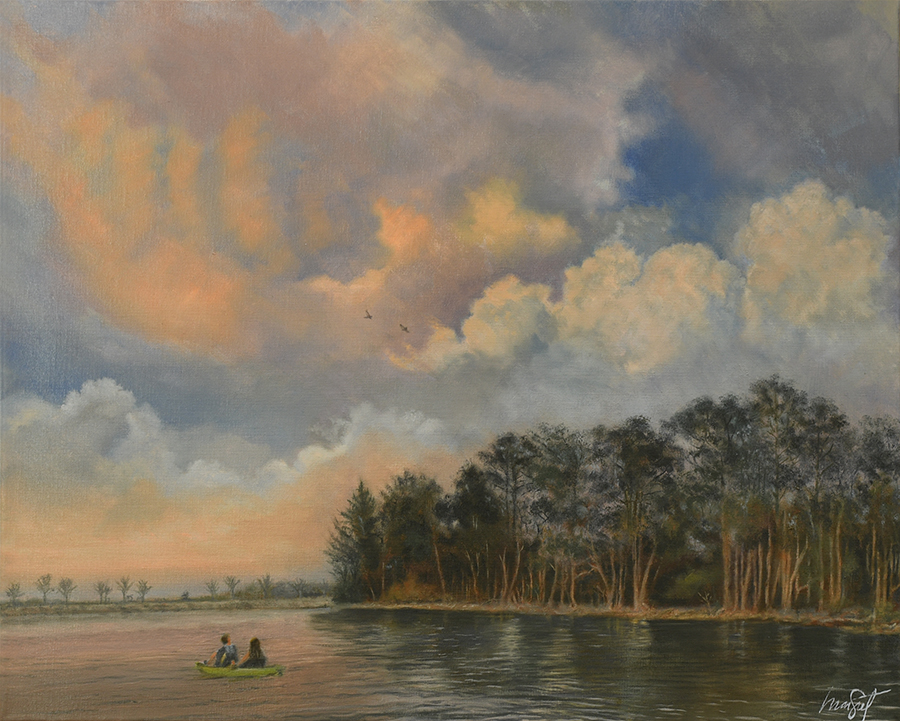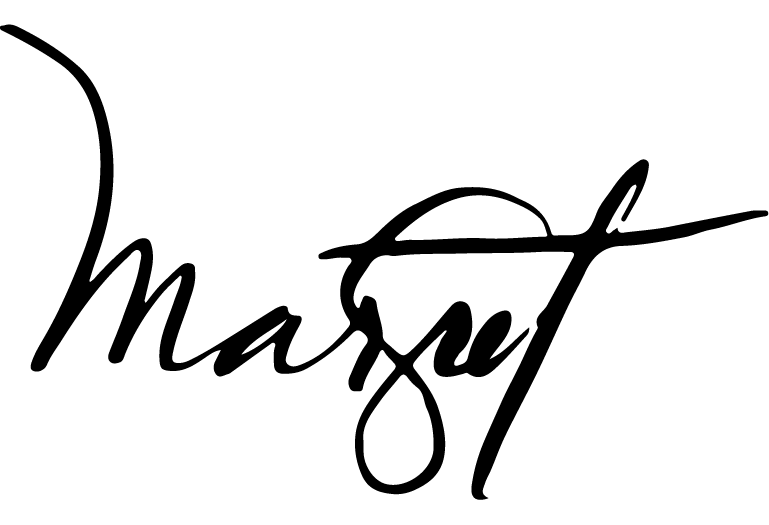
Commissioned Landscape: Kayakers on Indigo Lake, oil on canvas, 20″ x 16″
Just before sunset the neighbor’s yellow kayak slid through the water away from their dock next door to us, heading toward the far side of the lake. I sat on my dock sipping a glass of wine looking out at the lake. I was hoping to see interesting clouds and a beautiful golden hour, that short period of time before the sun goes below the horizon that artists favor for its warm, flattering glow. When it hits just right and there are clouds over the tree line to catch the sun, the glow is magical, lighting up the trees and the water as well. Low clouds shielded the setting sun that evening so there was no glow, but I was rewarded with an idea.
An Idea Emerges
My neighbors had asked me to create a landscape painting for them of the view of our lake with beautiful clouds in the sky at sunset. They approved a composition sketch I’d done so things were moving along. That night, sitting on the dock watching them out on the kayak, though, I knew that I had to paint them into the scene. I knew that it would make their painting that much more personal and special to them. And to be honest, it drew together two types of paintings that I enjoy doing, landscape and figurative, so I was excited to work on it as well.
I proposed the idea, and they were as excited as I was to do it. I planned out the time to have a photo shoot of them kayaking to coincide with the golden hour. We live next door to each other, so we met at our lakefront and each got into our kayaks. Out on the lake I trailed behind them. Once again we didn’t get dramatic clouds, or a rich golden hour, but I took lots of shots of the two in the other kayak and at one point, over the phone, I said, “OK, now tilt your heads up and to the right.” Click. I got the perfect shot.
Back in the studio I used Photoshop to composite several other shots I’d taken together for the final composition.
Composition
The challenge of the composition was in making the strong, unbroken horizontal line of the opposite shore of our lake visually interesting. To break up that line I placed the viewer at an acute angle to the shore such that the section with the line of tall trees to the right meets the section to the left with the palm trees in a wide-angled V-shape. I used atmospheric perspective, using lighter colors with a blue tint and softer focus on the left horizon line to make that part recede a bit, further breaking up the horizon line. The clouds were taken from a reference shot I’d taken a while back and placed a few degrees to the left to suit my composition. I also rearranged the clouds to create a pleasing wide U-shape to draw the eye around the scene. The two birds were grabbed from a video I took of a single bird, taking two different frames with differing wing positions. I placed them such that it looks like the two figures are looking at them and enjoying the spectacular clouds.
Meaning
Classically, you are taught in art classes to create compositions that draw the eye around the scene. All the things I describe above are designed to do just that, but the real draw to the eye is meaning. A study (find the abstract here) done a few years ago confirms this. The people and the birds connect us to the scene because they have meaning and tell a story, and stories have been the life blood of humanity for a millennia.
Scale
Another reason artists add figures to landscape scenes is to convey scale and lend perspective. We are small and the world is vast. Without them it would be more difficult to gauge the size of the space this scene takes up. Having the two small figures in this scene reminds us of that and gives us a sense of the grandeur of the world around us.
Our Beautiful World
In my view, it is important that we as the human race remember our place in the world and take proper care of it so that this beauty remains for generations to come. Landscape paintings such as this connect us to the earth and remind us of it’s importance and splendor.
